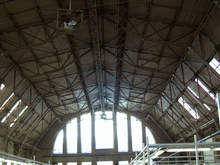Riga Central Market

The Riga Central Market ( lett. : Rīgas Centrāltirgus ) is the largest food market in Latvia . In the 1930s it was considered the largest and most modern market in Europe .
history
Already in 1910 a branch was planned from the central station of the railway in the direction of the Riga city canal , where at that time the red granaries with a food market were located.
After the First World War , the hygienic conditions on the food market were to be fundamentally improved. The bank on the city canal and the Daugava (German: Düna), as well as the market area had suffered severe damage in the First World War. With the establishment of the central market, the area should be put back in order.
After the Riga city council passed the resolution to rebuild the market on December 28, 1922, the government bought the two airship halls from the Wainoden airship port in Courland ( Kurzeme in Latvia ) . For structural reasons and hygienic requirements, only the upper parts of the halls were used.
Construction work began in June 1924 with the removal of the “red storage facilities”. In the course of the construction work there were various changes to the original project. Because of this, the construction work was interrupted in 1926 and only continued again in 1928. On November 2, 1930, the food market could then be handed over with a service .
Since 1995, the market has been run as a 100 percent AG of the Riga City Council. The central market employs 253 people and offers a total area of 72,300 m².
Technical specifications
A total of five market halls were built from the two airship halls, each of which was originally 240 m long - a larger one in east-northeast orientation with a length of about 140 meters and an area of 5,000 m² for wholesale and meat processing as well as 4 smaller halls in a south-south-east direction with a length of about 70 meters and about 2,500 m² for meat products, milk and meat products, bread, fruit and vegetables as well as poultry and fish.
The total area of the central market is now 5.7 ha, 1.6 ha of which is covered. The construction of the market then cost the city over 5,000,000 lats .
The use of the hall has been distributed according to the following scheme since 1995:
- vegetables
- milk
- flesh
- fish
- gastronomy
Sales development
After it opened in 1930, the central market became the largest trading point for all kinds of food. The farmers sold their products in the new, bright and clean market cheaper than in comparable shops. In 1931, goods were sold on a total of 41,000 m² with an annual turnover of around 750,000 lats.
With the abolition of wholesaling and the nationalization of agriculture during membership of the Soviet Union , prices rose and were higher than in the shops. Farmers were only allowed to sell their own products outside the halls.
Since the regaining of independence in Latvia, there has been free trade again. The market offers all products in the halls and also in the open spaces at lower prices than in corresponding shops.
In 2001, products were sold on a total area of 72,300 m² for a total of 4.6 million lats.
Movie
- In the belly of Riga. The central market. Documentary, Germany, 2015, 43 min., Script and direction: Stefano Tealdi and Uldis Cekulis, production: Stefilm, Ma.ja.de, ZDF , arte , RAI , RSI , HRT , series: Im Bauch von ... , first broadcast: 16 July 2015 at arte, table of contents by arte.
Web links
- The Riga Central Market (English)
- Photo gallery of the Central Market (English)
Coordinates: 56 ° 56 ′ 38.4 " N , 24 ° 6 ′ 57.6" E

